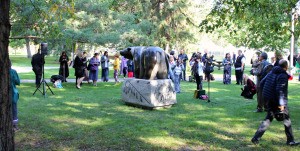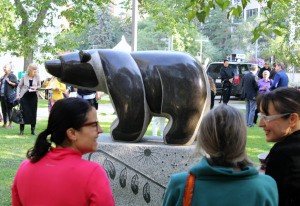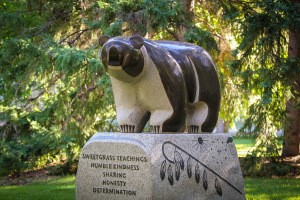
When I was younger, there was a wide-spread cultural ban on writing down the information found inside of Indigenous knowledge, or on voice recording and/or video recording events where Indigenous knowledge was in use, for instance during what is commonly referred to as “ceremony”. Over a very long history of practice, Indigenous knowledge has been designed to be transferred in the present moment, person to person, and there are crucial elements involved during this transfer process which do not lend themselves to being recorded, and which will not show up on such recordings. Hence the ban, an effort to keep the knowledge base pure and effective.
At this Truth and Reconciliation Commission moment in Canadian history, The Academy has been tasked with, and is responding to, recommendations coming out of the TRC final report. That there are even any Indigenous knowledge holders alive in 2016 is quite miraculous, given the extent of effort devoted by Canadian society in an all-out attempt to exterminate this knowledge, over the entire course of Canada’s history, coming up to 150 years. From an Indigenous perspective, it is the nature of the knowledge, itself, passed from person to person, in the present moment, all of the way through the course of a current 149 year history, that has kept it alive, still here with us today.
Through a collaboration between my cousin, Diana Steinhauer, and myself, Stewart Steinhauer — both 5th generation descendants of “the stolen boy”, Henry Bird Steinhauer, residing at modern day Saddle Lake Cree Nation — Indigenous knowledge, passed generation to generation, has been preserved and recorded in a specific format, both in form and in practice: in granite. The objective of this form of recording is to create an experiential moment for observers, transforming them from observers into participants.

By becoming present moment participants, the central crucial element of Indigenous knowledge transfer in the present moment, on an individual personal basis, can be fulfilled. Without going into detail about what such experiences may be like, were like for other people in the past, or could be like for people in the future — and here I find myself bumping into my own internalized version of the ban on writing down Indigenous knowledge — I will describe in generalized terms who the Sweetgrass Bear is, what her relationship is to Treaty Six Territory, and how that relationship helps define the Indigenous understanding of Treaty Six.
So to begin:
Grandfather sweetgrass, cleanse and prepare us, here, now, for what we are about to do.
Great Mystery, force of creation, see me here in my humble and pitiful condition, bless me, hold me, care for me, sustain me through this.
Sweetgrass Bear, grandmother, grandfather, see me, hold me, care for me, in this moment.
Sweetgrass Bear, when I see your four legs, I remember your four laws, humble kindness, sharing, honesty, and strength.
Sweetgrass Bear, when I see that the colour of your claws is the same colour as the roots of the sweetgrass, I remember how your laws are rooted down into the earth.
Sweetgrass Bear, when I see you here, with me now, I feel, inside of my own soul, my connection through you down into the earth.
Sweetgrass Bear, protector of the earth, help me now, with my own work, to share your teachings, to reach out to all people, all of the people who have come to share our land, here in Treaty Six Territory.
And you, my Rock Grandfather, thank you thank you thank you, my deepest gratitude, because you chose me, you pulled me up out of the despair that filled my life, you averted my suicidal attempts, you brought a deep joy where there was pain, and though there still is pain, you assuage that pain and give me hope, through your communications, to me, through me, to my suffering fellow humanity.
Rock Grandfather, use my body, use my hands, use my heart and soul, use my physical, mental, emotional and spiritual strength, to work with granite, shape and finish granite into forms that will communicate to all of the people who have come to share in our beautiful land, enjoy the bounty of our lands.
Rock Grandfather, please straighten out my words, here, as these words travel out into the minds of the readers, help us communicate, help open a space for us to come to a common understanding about who we are, as human beings, and what our relationship with our Great Mother, the earth, is.
In gratitude,
Stewart Steinhauer, 2016

Stewart Steinhauer — Stone Sculptor
Steinhauer is self-taught as a stone sculptor/foolish person, beginning his adventures in stone sculpture the day after the birth of his first child, in July 1973. After seventeen years of using the stone sculpture process as unconscious art therapy (on his own foolish self, of course), he was tossed into the maelstrom of the professional gallery system. Over the decade 1991–2001 he produced 21 exhibitions’ worth of new works in shows from Victoria BC to Stratford, Ontario. His works are in private collections around the world, and in public collections in BC and Alberta. Steinhauer’s works are represented in Edmonton by Lando Gallery, in Banff by Canada House Gallery, and in Creston, BC, by Kunze Gallery. He maintains on-reserve studio locations in both BC and Alberta.
Read about the unveiling of the Sweetgrass BearRead about the unveiling of the Sweetgrass Bear.